The Royal Navy has conducted a pioneering trial demonstrating the launch and recovery of uncrewed underwater vehicles (UUVs) from a submarine, expanding the capabilities of the UK’s nuclear-powered attack submarines.
According to a news update received by the UK Defence Journal, the trial took place in the Mediterranean under Project Scylla.
The exercise successfully tested the use of torpedo tubes to deploy and retrieve autonomous systems designed for underwater reconnaissance, communication, and seabed warfare missions.
Project Scylla is being delivered through AUKUS Pillar 2, which focuses on developing advanced defence technologies to strengthen security across both the Indo-Pacific and Euro-Atlantic regions. The trial represents an early milestone in integrating such technologies into frontline operations.
Commodore Marcus Rose, Deputy Director for Underwater Battlespace Capabilities, said: “Delivery of these trials demonstrates our commitment to the use of advanced capabilities as part of a future hybrid Fleet and are a big step forward in delivering new capability to the Submarine Service.”
The Royal Navy said that trials such as this form part of its Atlantic Bastion ambition, which aims to incorporate advanced technologies including autonomous systems and artificial intelligence to boost the effectiveness of the Fleet in contested environments.
The trial was conducted by the Submarine Delivery Agency’s Autonomy Unit, in partnership with L3Harris, a key industry provider of autonomous maritime systems.






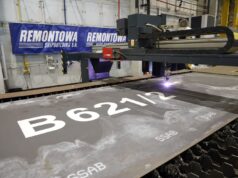
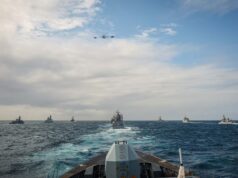

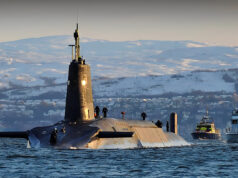

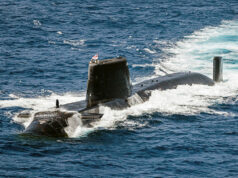

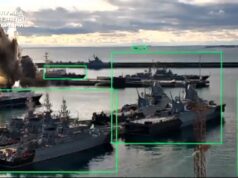
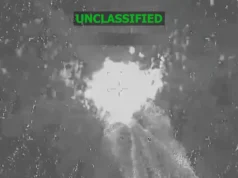

Yep, this is pretty damn cool!
You are correct. What a breakthrough!
Lovely piece of kit
Actually, could envision autonomous, AI enabled UUVs supporting the missions of both SSNs and SSBNs. Certainly, any required mission specific design changes could be incorporated into the SSN(A) design process, and perhaps even in the Dreadnought class production phase. Same rationale should apply to both Columbia and Virginia classes.
USS Delaware (SSN 791), a Virginia class sub already did the same thing with a Yellow Moray UUV (HII REMUS 600 variant) at the beginning of June.
Paul,
Thanks for the info, missed that news item. 👍
Interesting
Good post
Immense possibilities, but does anyone know if deploying UUVs will reduce the Astutes’ capacity to carry Spearfish and Tomahawk?
The simple answer is yes it will reduce the offensive armament. By how much will depend on how many of these are carried (not sure of their length/weight) down in the ‘bomb shop’.
Depending on size/weight, they will almost certainly be stored on the weapon racks until needed.
Perhaps SSN(A) will have a separate suite of smaller tubes to accommodate this type of sensor.
Iver4 900 is 2.5m long so assume this version is similar.
It navigates its way back through the torpedo tube which has a much larger diameter. I don’t think USN which trialled this in 2923 plan to do any more than alter the tube hatch to facilitate recovery.
2023
Just read the article on NL about it. Dimensions for it using the TT aren’t really an issue as the TT has a diameter of 533mm and is long enough to house a Spearfish torpedo.
What is interesting during its recovery phase is does it just ‘drive in’ or does it need to ‘reverse’ in? The kit is approx 8ft long and having to turn it around(weight unk) to eventually reuse it isn’t an easy evolution in a ‘bomb shop’ full of weapons.
Not entirely sure what’s involved with having to alter the ‘shutters’ on the tubes, as can’t see them altering anything on the actual ‘bow cap’ as it forms part of the watertight integrity of the tube.
It’s obviously early days in this trial, so suspect that Astute had plenty of space in her ‘bomb shop’ to manoeuvre said vehicle around safely. Not necessarily going to be the case with a fuller weapons outfit.
If you had been referring to the MoD that date would have been taken as read methinks. 🤔
I suppose with SSN/A having vertical launch silos for cruise missiles it will take a bit of stress from the Bomb room in that they no longer need to take up rack space with cruise missiles..
That is correct, means more of everything given that there will be two separate launch systems. It is entirely possible that we also go with a second set of smaller diameter torpedo tubes (400mm) for UUVs like the Swedish Gotland/A26 class employ. Early days for all of this, but not beyond the realms of possibilities, with much being dependent on what size of UUVs the RN want to use.
Hi Deep, I have to say that the idea of launching and retrieving via the Torpedo tubes is just an amazing engineering achievement and if this is the first visible product from AUKUS pillar 2 it’s a damn fine start. You have 2 independent submersible entities that both have to come to a matching, accurate depth setting and then maintain that using neutral buoyancy, then one has to propel itself back into 21 inch Torpedo tube.
I may be wrong but surely launching a smaller diameter UUV out through a 21 inch tube as per a torpedo is probably not a good idea unless it is encapsulated somehow (risks damage to tube and UUV) a bit like an artillery sabot. I’m no submariner but I’d have thought that if it can self propel back into a flooded up 21 inch tube it would be easiest to just self propel it out. In which case why go for a smaller diameter tube in future as recovery is more difficult.
As for them impacting the numbers of weapons in the Bomb room, well yes in an Astute but not necessarily in the future SSN(A), if they do fit VLS for TLAM etc and keep the weapons space as is, then it may not impact them at all.
Deep,
SSN(A) will be a fearsome beast prowling the deep, especially if equipped w/ SLCM-N eventually.
@ABCR, yes agree it’s probably the way ahead especially for SSN(A), which is can still see having 2 sets of different diameter tubes as well as VLTs. Perhaps a smaller set for expendable UUVs, who knows.
Yes it’s a significant challenge getting something back into the tube remotely, puts the SSN at a tactical disadvantage during the recovery phase.
I imagine that the UUV sits in some sort of cradle whilst in the tube, then when ready swims out under it’s own power as you say. Just can’t see it being discharged using the WRT system, far too much force if you consider the system ejects a 1800Lb Spearfish with ease!
You are probably correct in terms of ‘Bomb shop’ space on the SSN(As). Will be interesting to see how this actually progresses.
@FUSAF, greetings fella, here’s hoping that we get all our ducks in a row when building and equipping this beast when we as you say, eventually build them.
Would be absolutely delighted if we actually get to the 12 units that have been referred to elsewhere. Instead of a bottle of vin rouge, I’d pr open a case and seriously enjoy it!!!
@ABCR, should say WRD system and not WRT, typing in auto instead of paying attention.
Potentially another big advantage nuclear boats will have over electric boats, bigger hulls will mean more space to carry autonomous systems and their are so many uses for autonomous systems.. especially if your willing and able to sacrifice them.
Lots of questions on the pros and cons of nuclear vs conventional subs as always a trade off, a single US current Virginia SSN Class approx eight times the cost of a the new Japanese Taigei Class and US only building one a year (actual number per annum in 2024 was equivalent of 1.15) the 7 Astute’s taking approx 19 years from the first commissioning in 2010 to the last in 2029.
I wouldn’t extrapolate too much from the Astute timelines.
There were two major redesigns as well as the lack of skills.
Exactly, the S & T boats were being built at a rate of approx one every 18-24 months. All about having the right number of qualified people in the right place at the right time – or, having g all your ducks in a row.
We have time to significantly reduce the build time over the next 5 years or so to get back to those build times. HMG just need to invest in the whole process, indeed if Aus are to receive 5-6 boats and we do actually do get 12 units, then the build process will need to be accelerated to take into account when the individual A boats reach their OSD.
Yes I’m sure the Russian fleet is not looking forward to this becoming widespread, even the mention of drones makes them run for cover. I wonder if terminal drones released by submarine launched carrier drones might be the next step though specialist launch options might be desirable to take full advantage, but would be a nightmare to defend against if fully matured.
Great possibilities, I agree. But we need something to carry them in.
The RN has one, yes one, seaworthy sub at the moment. When is availability expected to improve?
Availability won’t improve for a while, Xmas at the earliest would be my guess. However, if war suddenly broke out then we would probably surge 3 units, and concess some of the peacetime safety aspects that is currently keeping these assets alongside.
I’m sure Eagles has an answer James, though probably not one that actually enlightens us further.
Very exciting development.
Could the drones by stored alongside Spearfish and Tomahawk in the bomb shop? This would increase the sub’s capacity without compromising armament.
With drones now also being deployed from aircraft carriers, this technology seems to be a strong emerging innovation.
Perhaps, for operations, non recovery is a option?